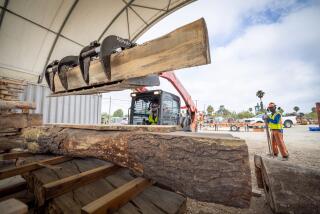The Provosts of Compost
- Share via
Ah, the fertile byways of higher education--ethnomusicology, Romance languages and, of course, composting. The eight-week Master Composter course offered by Encinitas-based Solana Recyclers gives matriculants comprehensive instruction in the alchemical process of recycling yard clippings, food scraps and so on into “gardener’s gold.” “If you just want to know how to compost, you can pick it up in an hour,” says Tammy Tatum, program coordinator and instructor. “But we go over 30 hours of material.”
The curriculum covers such nuances as soil chemistry, nitrogen-to-carbon ratio, waste-management issues and vermicomposting techniques, as well as public speaking and presentation skills. Like any rigorous college course, the instruction culminates in a final exam, which leads to a “Master Composter” certificate from Solana. Master Composters can give workshops and lecture at community organizations about the prized decomposing piles. “People come to the class looking for an answer to the elusive question, ‘How can I get beautiful compost in as little time as possible?’ ” says Tatum, who completed the course in 1995. “By the time we finish, they’ll have the tools to do that, but they’ll also be able to answer questions about the environment.”
San Diego County started the course in 1994 and Solana Recyclers, a nonprofit organization focusing on environmental education, took it over a year later. Nearly 180 students from across Southern California have graduated to certified status. (Riverside County offers a similar class limited to residents of that county.) The program is usually held once a year, in the spring or fall, and is free but for a $25 materials fee. In return, enrollees must complete 30 hours of compost-related community service. “When we’re reviewing applications, we look for people who like to volunteer and get involved with their neighborhoods,” Tatum says. “Our goal is to get as many people as possible educated about composting.”
To the true scholar, of course, the quest for knowledge--and the perfect compost recipe--is never-ending. For the record, Tatum suggests amassing at least 27 cubic feet of half “browns” (leaves, straw, shredded newspaper) and half “greens” (grass clippings, food scraps) all at once, and then turning the hot pile whenever it starts cooling, for a lovely compost in just three weeks.
*
Solana Recyclers, 137 N. El Camino Real, Encinitas; (760) 436-7986






